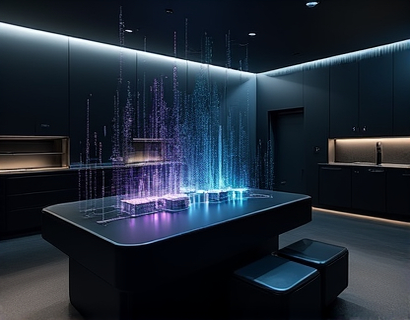Mastering Mindfulness: Innovative Software for Stress Relief and Relaxation
In today's fast-paced world, stress has become an almost constant companion for many individuals. The relentless demands of work, personal responsibilities, and the continuous influx of information can lead to mental fatigue and a sense of being overwhelmed. Amidst this chaos, the practice of mindfulness emerges as a beacon of hope, offering a pathway to relaxation, mental clarity, and inner peace. This article delves into the realm of innovative software designed to facilitate mindfulness and meditation, providing users with powerful tools to manage stress and enhance their overall well-being.
The Importance of Mindfulness
Mindfulness, at its core, is the practice of being fully present and engaged in the current moment, without judgment. It involves paying attention to thoughts, feelings, and sensations in a non-reactive manner. This practice has roots in ancient traditions but has gained significant traction in modern psychology and wellness practices due to its numerous benefits. Research has shown that regular mindfulness practice can reduce stress, improve emotional regulation, enhance focus and concentration, and even boost the immune system.
In a world where unfocusing is rampant, mindfulness offers a counterbalance. It helps individuals break free from the cycle of constant distraction and mental chatter, allowing them to find moments of tranquility and clarity. By cultivating mindfulness, one can develop a greater awareness of their thoughts and emotions, leading to more thoughtful and intentional actions.
Innovative Software for Mindfulness and Meditation
The integration of technology into mindfulness practices has opened up new avenues for individuals seeking to incorporate relaxation and meditation into their daily lives. Innovative software solutions have emerged, designed to guide users through the process of mindfulness and meditation, making these practices more accessible and effective.
These platforms offer a range of features tailored to support users in their journey towards a more balanced and peaceful mind. Guided meditation sessions, calming soundscapes, and mindfulness tools are just a few of the components that make these software solutions powerful allies in stress relief and relaxation.
Guided Meditation Sessions
One of the most valuable features of mindfulness software is the availability of guided meditation sessions. These sessions are led by experienced instructors who walk users through the meditation process, providing clear instructions and gentle guidance. The guided nature of these sessions is particularly beneficial for beginners, as it helps them understand the basics of meditation and build confidence in their practice.
Guided meditations can focus on various themes, such as stress reduction, sleep improvement, anxiety relief, and self-compassion. Each session is carefully crafted to address specific needs and goals, ensuring that users can find the right type of meditation to suit their current state of mind. Whether you are dealing with a stressful day at work or seeking a moment of peace before sleep, there is a guided session available to help.
Calming Soundscapes
Sound plays a crucial role in creating a conducive environment for meditation and relaxation. Calming soundscapes, such as nature sounds, white noise, and soft instrumental music, can significantly enhance the meditation experience. These auditory elements help to mask distracting noises and create a serene atmosphere, making it easier for the mind to settle and focus.
Mindfulness software often includes a library of high-quality soundscapes, allowing users to customize their meditation sessions according to their preferences. From the gentle rustling of leaves to the soothing sound of ocean waves, these soundscapes can transport users to a state of deep relaxation, further amplifying the benefits of meditation.
Mindfulness Tools
Beyond guided sessions and soundscapes, mindfulness software provides a variety of tools to support users in their practice. These tools are designed to foster a deeper connection with the present moment and enhance the overall mindfulness experience.
One such tool is a breathing exercise guide, which helps users focus on their breath, a fundamental aspect of mindfulness practice. By following the instructions, users can learn to regulate their breathing, reducing stress and promoting relaxation. Another useful feature is a gratitude journal, where users can reflect on positive aspects of their lives, cultivating a more optimistic and grateful mindset.
Additionally, many platforms offer mindfulness reminders and prompts, encouraging users to take short breaks throughout the day to practice mindfulness. These reminders can be particularly helpful for individuals who find it challenging to maintain a consistent meditation routine, as they provide gentle nudges to stay on track.
Benefits of Using Mindfulness Software
The integration of mindfulness software into one's daily routine can lead to numerous benefits, both mental and physical. Here are some of the key advantages:
- Reduced Stress and Anxiety: Regular mindfulness practice has been shown to lower levels of stress hormones like cortisol, leading to a more relaxed and calm state of mind.
- Improved Focus and Concentration: Mindfulness helps train the brain to stay focused on the present moment, reducing mind wandering and enhancing cognitive functions.
- Better Emotional Regulation: By increasing awareness of thoughts and emotions, mindfulness practice enables individuals to respond to challenging situations more thoughtfully, rather than reacting impulsively.
- Enhanced Sleep Quality: Guided meditations and relaxation techniques can help improve sleep patterns, leading to better rest and recovery.
- Increased Self-Awareness: Mindfulness fosters a deeper understanding of oneself, promoting self-acceptance and personal growth.
These benefits collectively contribute to a more balanced and fulfilling life, where individuals can navigate the demands of daily life with greater ease and resilience.
Getting Started with Mindfulness Software
For those new to mindfulness and meditation, starting can seem daunting. However, mindfulness software makes the process straightforward and accessible. Here are some steps to get started:
- Choose a Platform: Select a mindfulness software that aligns with your needs and preferences. Look for platforms that offer a variety of guided sessions, soundscapes, and tools.
- Set a Routine: Consistency is key in mindfulness practice. Dedicate a specific time each day for meditation, even if it's just a few minutes to start.
- Begin with Guided Sessions: Start with guided meditations to get a feel for the practice. As you become more comfortable, you can explore unguided sessions or practice on your own.
- Experiment with Soundscapes: Try different soundscapes to find what works best for you. Some people prefer nature sounds, while others find instrumental music more soothing.
- Use Mindfulness Tools: Incorporate mindfulness tools into your daily routine, such as breathing exercises or gratitude journaling, to deepen your practice.
By following these steps, you can begin to integrate mindfulness into your life, reaping the numerous benefits it has to offer.
Creating a Mindful Environment
While mindfulness software provides valuable tools, creating a supportive environment is equally important. Here are some tips to help you establish a conducive space for meditation and relaxation:
- Designate a Quiet Space: Find a quiet corner in your home where you can meditate without interruptions. This space should be comfortable and free from distractions.
- Use Comfortable Seating: Invest in a comfortable cushion or chair that supports your posture during meditation.
- Incorporate Soft Lighting: Soft, warm lighting can create a calming atmosphere, making your meditation space more inviting.
- Add Personal Touches: Decorate your space with items that bring you peace and joy, such as plants, candles, or inspiring quotes.
- Minimize Digital Distractions: Turn off notifications on your devices or use apps that block distracting content during your meditation time.
By creating a dedicated and comfortable space, you can enhance your mindfulness practice and make it a more enjoyable and effective experience.
Overcoming Challenges in Mindfulness Practice
While the benefits of mindfulness are clear, many individuals face challenges in maintaining a consistent practice. Here are some common obstacles and strategies to overcome them:
- Lack of Time: With busy schedules, finding time for meditation can be difficult. Start with short sessions and gradually increase the duration as you become more comfortable with the practice.
- Difficulty Staying Focused: It's normal for the mind to wander during meditation. When this happens, gently bring your attention back to your breath or chosen focus without judgment.
- Feeling Uncomfortable: Some people may experience physical discomfort or emotional distress during meditation. If this occurs, try adjusting your posture or taking a break. It's important to approach meditation with kindness and patience.
- Skepticism About Effectiveness: Doubting the benefits of mindfulness is common. Keep in mind that the effects of mindfulness can be subtle and cumulative, so be patient and persistent.
By acknowledging these challenges and implementing effective strategies, you can overcome barriers and maintain a consistent mindfulness practice.
Conclusion
In an era where stress and unfocusing are prevalent, mindfulness software offers a powerful tool for individuals seeking to enhance their mental well-being and achieve a more balanced life. Through guided meditations, calming soundscapes, and mindfulness tools, these platforms provide a comprehensive approach to relaxation and stress relief.
By integrating mindfulness into daily routines, individuals can experience a range of benefits, from reduced stress and improved focus to better emotional regulation and enhanced sleep quality. The journey towards mindfulness is a personal one, and with the right support, anyone can cultivate a more peaceful and fulfilling life.
Embrace the transformative power of mindfulness and discover the profound relaxation and inner peace that await.










































